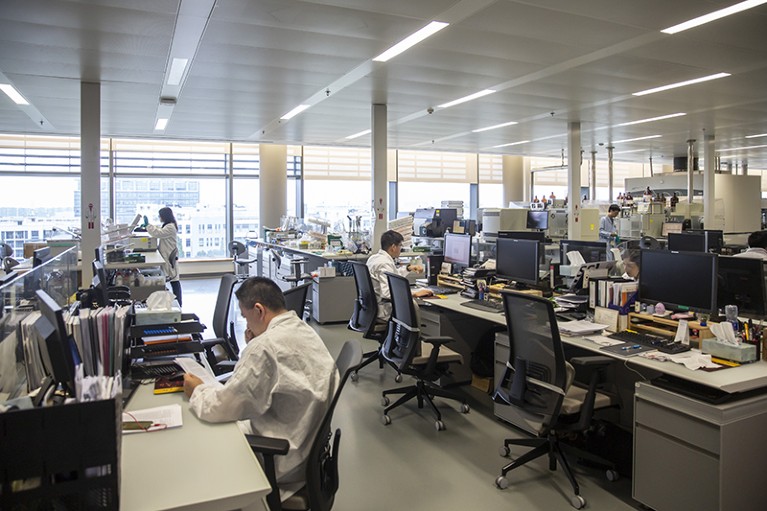
Industrial research often focuses on patents rather than publications, which researchers wanting to return to academia might need to consider.Credit: Qilai Shen/In Pictures via Getty
Whereas many researchers talk about a move to industry as an irreversible step, some treat their time away from academia as a career-enhancing sabbatical. Advice on navigating this move — permanent or otherwise — can be hard to find.
In Nature’s 2022 survey of graduate students, 47% reported dissatisfaction with their current level of guidance on career pathways (go.nature.com/454xtj3). Previous surveys show that early-career researchers want to pursue an academic career path: in 2020, for example, 63% of postdoctoral scholars expressed a wish to stay in academia (go.nature.com/46ecrcp). But those who have made the move to industry tend to be happier and better paid, according to Nature surveys in 2019 (go.nature.com/375hgjt) and 2020 (go.nature.com/45kjk2v) .
Some academics who dip their toes into the private sector realize that it’s not for them. Yet returning to academia isn’t always seamless, given differences in compensation, expectations and work cultures.
Nature asked four scientists to reflect on their returns to academia and to offer suggestions for early-career academics considering their own transitions.
JEREMY SIVAK: Adapt to different work cultures
Senior scientist and glaucoma research chair at the Krembil Research Institute in Toronto, Canada, and associate professor at the University of Toronto School of Medicine.
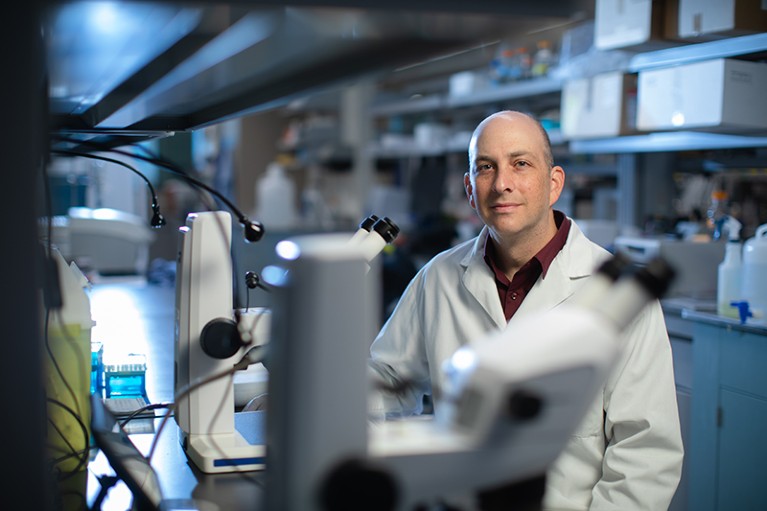
Jeremy Sivak worked at the US drug firm Novartis before returning to academia in Canada.Credit: UHN Foundation
A fluke led me to industry. In 2005, I finished a postdoctoral fellowship at the University of Cambridge, UK, on tissue morphogenesis and repair, and I was thinking about next steps. I was interviewed for an assistant-professor role that didn’t happen, but a few months later the interviewer called me. They said they were moving to industry and asked if I would like to join them. It was a chance to try something different and move my family back to North America.
I joined a small but rapidly growing department at the pharmaceutical company Novartis in Cambridge, Massachusetts. I spent five years there as a project lead in ophthalmic drug discovery, returning to academia in 2010 as an assistant professor at the University of Toronto, Canada. In academia, there are some common misconceptions about industry. For instance, that the workload is lighter, that because you don’t have to apply for grants in the same way, you don’t have to justify your resources and that there’s less creativity. That’s not really true: the pressures and the creativity are still there, they just take a different form.
In my experience, however, industry is wildly different when it comes to collaboration. There’s a shift from the academic environment — where projects tend to be small in scale and very focused — to working on multiple complex projects with various teams in industry.
For example, in toxicology in an industry setting, one person might apply their expertise to many projects run by different teams, each with varying problems to solve.
There’s pros and cons to that. On the one hand, you don’t face as much pressure to push this project forward alone. But you might also lose that feeling of ownership and success that comes with driving a project. On the other hand, there’s a lot of joy to be found in completing tasks or meeting milestones with a team.
Eventually, however, I felt like the odd person out. I chafed a bit under the top-down structure, in which strategic company decisions would flow down the chain of management. And I had my own curiosity-based ideas about what and how I wanted to study, which is why I started actively looking to come back to academia. I’ve never felt completely done with industry, though. I still have good relationships with my former colleagues.
For me, it’s important to pay attention to what the metrics used to evaluate success look like in different environments. I have seen people in private companies still acting like academics — starting side projects and grant applications — but I think that doesn’t work so well, because they’re not contributing as strongly towards the goals of the company or the main project.
There’s a striking difference between academia and industry in terms of the metrics for success. As an academic, your CV becomes your identity, but I had no publications during my time in industry. One of my challenges was to reframe my industry successes for an academic audience, although I was not able to discuss the details of some of those projects for proprietary reasons.
I think that my experience in industry certainly changed how I view my science and research, and now I can’t help but run my academic lab a little bit differently. I tend to take a translational focus; I try to put on my industry hat.
VINITHA M. THADHANI: Learn the language of the private sector
Adjunct professor of organic chemistry at the International Center for Chemical and Biological Sciences, University of Karachi, Pakistan.
It’s common practice in Sri Lanka, where I’m based, to be recruited as a senior lecturer once you finish your PhD. I joined the Institute of Chemistry Ceylon, a non-profit academic organization in Colombo, as a senior lecturer as soon as I submitted my PhD thesis in 2007. There, I was doing basic research in chemistry: isolating plant compounds and looking at their bioactivities.
In 2014, I shifted to the private sector and joined the Sri Lanka Institute of Nanotechnology (SLINTEC), also in Colombo, as a senior research development scientist. SLINTEC is a research institute run by the government and corporate partners, and conducts projects that are directed towards commercialization. The institute looks at the needs of industrialists, such as the end cost for research to go from the lab to a commercial product.
Pay, perks and culture shocks: a toolkit for scientists moving to industry
I gained experience in diverse sectors of applied chemistry, such as how to dye fabrics at lower temperatures and how to make a paint water-repellent. I developed a patented technology that can be scaled up to convert tea waste from a Unilever instant tea factory in Sri Lanka to a commercially viable textile dye.
In 2017, the SLINTEC Academy was formed to award degrees. In 2019, I became an associate professor there, and gained an affiliation with the International Center for Chemical and Biological Sciences (ICCBS) in Karachi as an adjunct professor in the same year. This academic affiliation helps me with publishing scientific papers, which I need to further my career.
I worked at SLINTEC and its academy until 2022, but I haven’t left industry fully. At the ICCBS, I test bioactive compounds from plant materials and work on textile dyes from waste materials. I’m also the research and development head of an Ayurvedic medicine company, and work as a consultant for an Indian pharmaceutical company.
When you’re working in industry, you might encounter business people who don’t know much about basic science. So you have to talk in the language that they understand. On the other side, they might talk to you about figures, costs and profits, so you also have to try to understand their language.
SAYAN RANU: Work out what drives you
Associate professor of computer science at the Indian Institute of Technology Delhi.
After I finished my computer science PhD in 2012 at the University of California, Santa Barbara, I was sure I wanted a research career. What I was less sure about was where: industry or academia. My initial preference was industry, because I thought it would pay better. I also wanted to go back to India, so two months later I joined IBM Research, the global technology company’s R&D division, as a researcher in Bengaluru. At the time, cloud computing, big data and artificial intelligence (AI) were perceived as important for the business, and these aligned with my own research interests.
I worked there for a couple of years and enjoyed it. But I realized that, whereas research is encouraged, ultimately the company is looking to make revenue. I felt that made it hard to have a long-term research agenda. Everything has to be linked to what is perceived as important for the business, and priorities always shift. I wanted more independence to choose my own research questions, and to do more fundamental research.
Careers advice from scientists in industry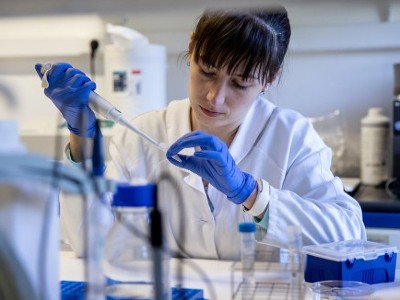
In industrial research labs, patents are very important, so before submitting a paper you have to get it verified by an intellectual-property team, which often delays publication. And given how fast-moving the field of AI and machine learning is, with a lot of people working in it, a small delay felt significant to me.
When I moved back to academia in 2014, as an assistant professor of computer science and engineering at the Indian Institute of Technology (IIT) Madras in Chennai, the remuneration was a big adjustment. My salary was about three or four times less than what I was making in industry. I had to settle for a smaller house, and I had to reduce the number of times I would visit my parents in Calcutta. I was never an extravagant spender, so I think for me it was a lot more of a mental adjustment than the various lifestyle choices. But looking back, I think I made the correct decision.
I see some of my own experiences with my students at IIT Delhi, which I joined in 2016 as an assistant professor, where I focus on network science and AI. Many students go for an internship at an industrial research lab and think that, if they later join in a full-time research position, it will have the same responsibilities as the internship.
I also did internships, which were positive. But in industry, I think many people ask interns to do research that can be slightly high risk, over a three-month period, and the internship projects feel similar to academic ones. When you’re there full time, the differences between academic and industrial research become clearer. I tell my students to observe their mentors in industry: to see whether they’re doing research all the time or if they’re also doing something else, such as presenting to clients.
I tell whoever I’m mentoring to work out what you really like doing, what drives you. It’s perfectly fine to say you don’t like research; there are a lot of frustrations with academic research. Do you want to publish and generate knowledge? Or do you want to create a product that you see people using after one year? There’s a lot of motivation that people derive from that. Both are important. Once you have that figured out, then start thinking about the compensation and those other things.
MARIANA MAYER-PINTO: Don’t be afraid of change
Scientia senior lecturer in marine ecology at the University of New South Wales, Sydney, Australia.
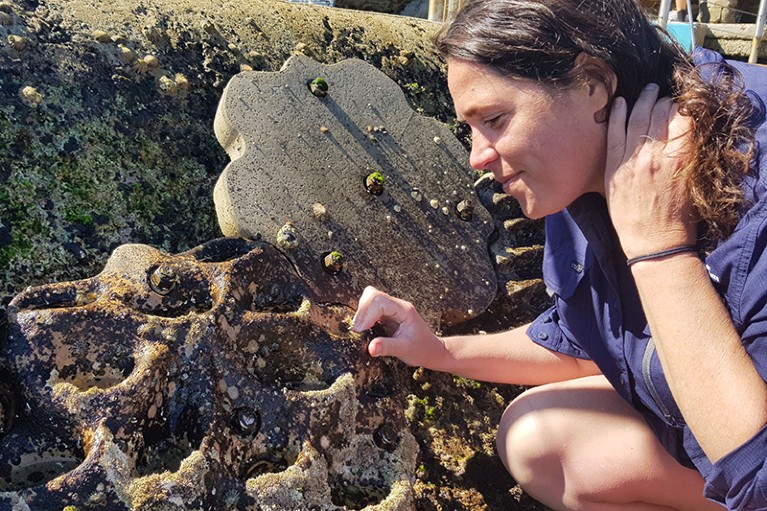
Marine ecologist Mariana Mayer-Pinto sees industry and academia as complementary sectors.Credit: James Redmayne/Reuters
After finishing my PhD in marine science at the University of Sydney, Australia, in 2009, I just felt a bit over academia. It was a mix of being tired and just wanting something new, so I went travelling for a few months with my partner in Argentina and Brazil (our home countries). We decided to come back to Australia together. An industry position then came up, for a natural-gas environmental project with the consultancy RPS, based in Perth, and I thought it was a good way to keep doing my science, but in different surroundings.
I was lucky — one of the reasons I got the job is because they were looking for people with skills from academia. I enjoyed my year and a half in industry in Perth, but my partner was in Sydney, and I missed the flexibility of academia, particularly now that I’m a mum.
After moving back to Sydney, I did some voluntary work for other researchers in my field, because I realized that I needed to be visible. I wrote to people, including one of my PhD examiners, who said she had a casual role available. And it evolved from casual to fixed term part time, and then to full time. It took a while, and I did some teaching-only positions until I got on a research path.
I used to earn a lot more when I was working in industry. For me it was a big step down, but in Australia the academic salaries are not that bad (except for PhD students).
I know this comes from a privileged place, but I think it’s important to do what makes you feel happy. Don’t be afraid of change. It can be daunting sometimes, but it’s worse being unhappy doing what you don’t want.
Sometimes you see polarization, such as that industry is better or academia is better. I feel we need to stop that. We should be complementary; rather than one being better or worse, it depends on what you want at a particular time of your life and what your interests are.

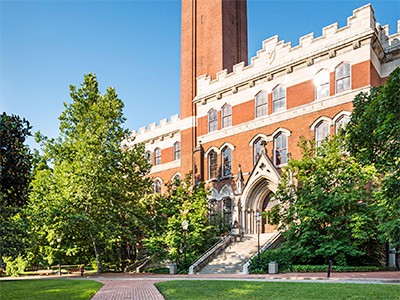
 Nature Career Guide: Faculty
Nature Career Guide: Faculty
 Pay, perks and culture shocks: a toolkit for scientists moving to industry
Pay, perks and culture shocks: a toolkit for scientists moving to industry
 Leaving academia for industry? Here’s how to handle salary negotiations
Leaving academia for industry? Here’s how to handle salary negotiations
 Breaking down the barriers that curtail industry collaborations and career moves
Breaking down the barriers that curtail industry collaborations and career moves
 Careers advice from scientists in industry
Careers advice from scientists in industry
 Advancing your Scientific Presentations
Advancing your Scientific Presentations






